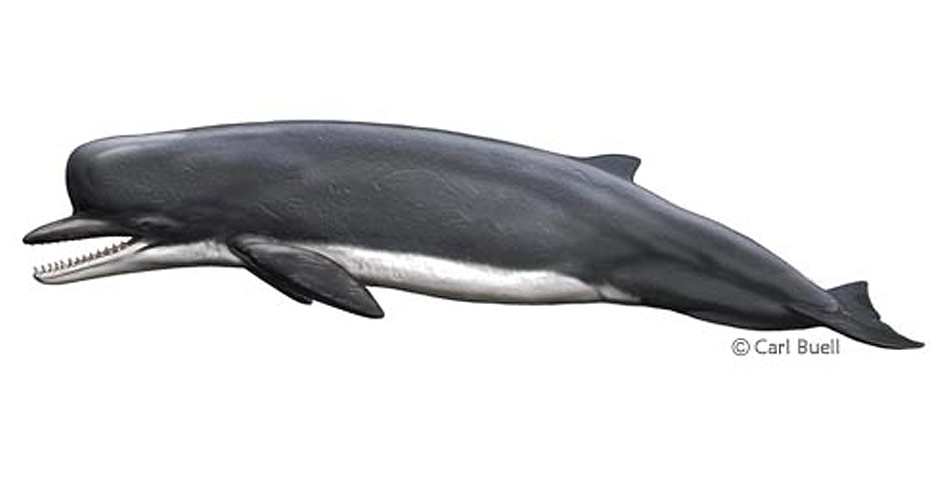
Zygophyseter varolai
Age: 8.14-10.5 million years ago, Miocene Epoch.
Range: Zygophyseter is so far only known from Italy, indicating that it inhabited the ancient Paratethys Sea, the precursor to the modern Mediterranean Sea.
Size: Approximately 6.5-7 meters in length (or 21-23 feet).
Anatomy: Zygophyseter would have been roughly similar to the sperm whale (Physeter) and the dwarf and pygmy sperm whales (Kogia). In modern sperm whales, the rectangular shape of the head is due to the 'spermaceti organ', which is a greatly expanded version of a fatty sac that is situated behind the nasal passages in dolphins and porpoises. In Zygophyseter, the bony basin on the top of the skull does not extend far onto the snout. This suggests that Zygophyseter would have had a 'beak' (snout) that continued well beyond the spermaceti organ. The modern bottlenose whale Hyperoodon has a similar appearance.
Locomotion: The vertebrae of Zygophyseter are generally similar to those of the modern sperm whale, Physeter. The skeleton of Zygophyseter indicates that it was a fully marine cetacean.
Sensory Abilities: The skull of Zygophyseter has a very large basin above the braincase, which is called the supracranial basin. This feature is developed in all modern sperm whales (Physeter, Kogia) and houses the spermaceti organ and the melon. The melon and walls of the basin are thought to focus echolocation clicks produced in the nasal passages, Thus like living sperm whales, Zygophyseter likely had a sophisticated system of echolocation.
Diet: One of the most important differences between Zygophyseter and modern sperm whales is the dentition. Zygophyseter retains deeply rooted teeth in the upper jaw, which are lost or no longer functional in all three species of modern sperm whales. Unlike Physeter, the teeth of Zygophseter are sharp, conical, and have well developed enamel. In the modern sperm whale, squid are brought into the mouth by suction and the teeth play little role in feeding. The large teeth of Zygophyseter and the large and robust bony regions where the jaw muscles attach all indicate that this extinct sperm whale has a strong bite. It may have fed upon smaller marine mammals in a manner similar to the modern killer whale (Orcinus). The skull of Zygophyster exhibits extreme asymmetry; one side is much larger than the other. In modern toothed whales, skull asymmetry correlates with the size of prey , thus the extreme degree of asymmetry in the facial bones of Zygophyseter independently suggests that it consumed large prey.
Author: Robert Boessenecker
References Consulted:
Bianucci, G., and W. Landini. 2006. Killer sperm whale: a new basal physeteroid (Mammalia, Cetacea) from the Late Miocene of Italy. Zoological Journal of the Linnean Society 148:103-131.
Cranford, T. W., M. Amundin, and K. S. Norris. 1996. Functional morphology and homology in the odontocete nasal complex: implications for sound generation. Journal of Morphology 228:223–285.